Rustic cottage garden ideas – 7 tips for creating a stunning garden on a shoestring budget
Kathy and Stuart Pickering created their rustic cottage garden in a stretch of field.
And you can use the same techniques to turn an empty lawn into a haven of colour and scent, filled with butterflies and birdsong.
Their space is equivalent to a long, narrow town garden, measuring around 30ft x 100ft, but the ideas would work in smaller and larger spaces.
And they’ve done it all on a minimum budget, recycling second-hand finds and using virtually no hard landscaping.
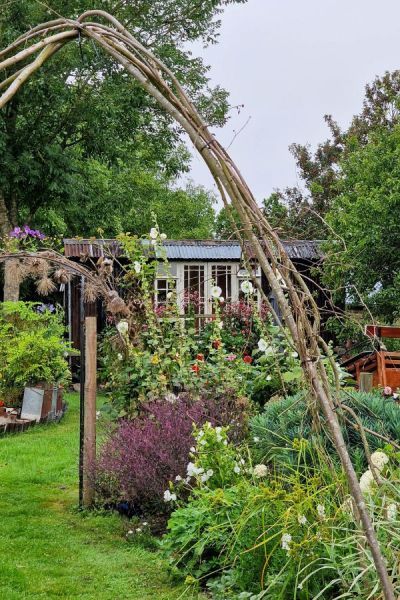
Kathy and Stuart created this rustic cottage garden from a strip of field.
Start with a plan
Kathy says she knew what she wanted to do, so didn’t have to think about it too much.
Cottage gardens are traditionally informal, but it makes sense to think about how you’re going to break up the space. There’s relatively little hard landscaping in cottage garden style, which makes it a good budget choice – Kathy’s seating area uses wood chip instead of pavers, the paths are grass and they made the arches themselves from hazel branches.
All the furniture and pots are bought from yard sales, car boot fairs or passed down by friends.

Cottage garden style – a simple, informal layout which you can put together without having to spend money on hard landscaping.
There’s more about cottage garden style and how to achieve it here.
Kathy marked out her garden zones with poles and paths. It starts with an open lawn area at the beginning.
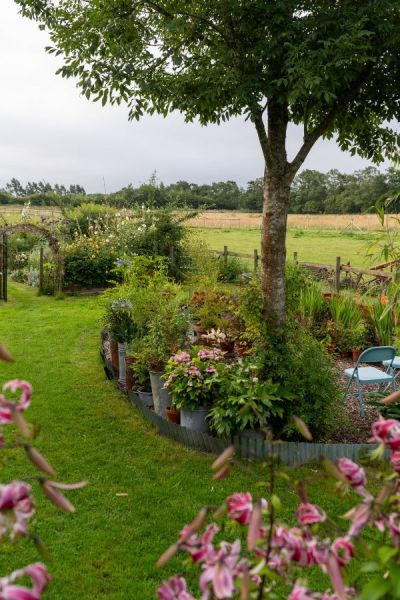
This is the open lawn at the start of Kathy and Stuart’s cottage garden, with an ‘oval’ for pots and seating. Note that the fencing is rustic – with beautiful views, they didn’t need anything more substantial.
Then the heart of the flower garden is a series of four borders on either side of a central path, going down to a second open meadow area at the bottom. If your garden area is long and narrow, this way of dividing it into zones across the space works very well to make it feel larger and blur the boundaries.
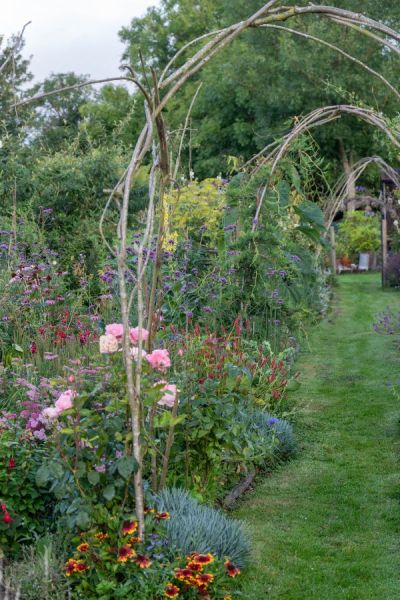
An arch and a gate marks off the first lawn area, and then there is a central grass path with borders on either side.
There are more tips for dividing up a long narrow garden here and read this if you have a very small narrow garden.
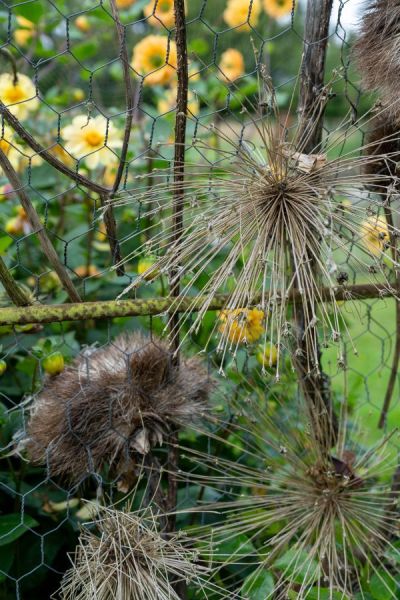
Kathy hangs dried allium heads on an arch she found discarded in a front garden (she asked the owner and they were glad for her to take it!)
How to create a garden border from scratch
Kathy created her borders in the easiest way. She and Stuart marked out the areas of border by laying down poles and covered this area with cardboard. The cardboard blocks the light, stopping grass and weeds from growing. Then it slowly breaks down over around five months to improve the quality of the soil. By this time, the grass and most of the weeds will have died off.
Kathy and Stuart covered the cardboard with very well rotted manure immediately after laying it down. They have horses, so they used a very old pile of manure, which meant Kathy could plant into the bed just a few weeks later. (If manure isn’t well rotted enough, it could ‘burn’ the plant stems).
Kathy began planting these beds a few weeks later. This called ‘no dig’, and is a much easier way of creating borders than the traditional method of digging up lawn, meadow or weeds with a spade. You can find out more about No Dig For Flower Gardens here.
A rustic cottage cabin
The garden is a short walk away from the actual house, but all gardens feel right when they’re anchored to a building. So Kathy and Stuart have created a rustic cottage cabin which Kathy calls her ‘dacha’.
They made the cabin by building up an old hay wagon, giving it sides made of corrugated iron. They’d recently renovated the corrugated iron roof of their cottage, so they re-used the old corrugated iron to make the ‘dacha’. They also insulated it and painted it inside.
Kathy visits car boot fairs and yard sales, as well as second-hand shops. She also keeps a keen eye out for bits and pieces that are being thrown away. Spotting a set of Victorian glass windows and a door apparently discarded in a front garden, she asked the owner if they were throwing them out. ‘We’ve been waiting for someone like you,’ said the owners, happy to know that their windows and door would have another use in a different place.
It’s important to ask, even if it’s clear that something is being thrown away or is in a skip.
The cabin is raised up, so they built a verandah with steps. They’ve placed planters made of old boxes in front of the verandah, and there’s a wonderful view down the garden over the tops of the flowers.
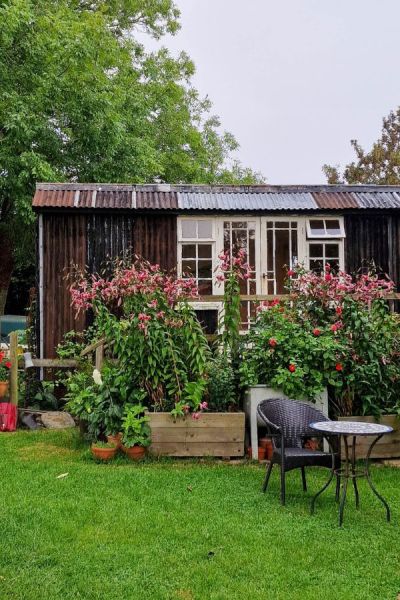
A rustic cottage garden shed made from an old haywagon and covered in recycled corrugated iron. The door and windows came from a Victorian house.
Top cottage garden plants
There are three ways of getting very cheap or free plants. You can propagate plants, sow from seed or share plants with friends when you divide overgrown clumps of perennials up.
You can also pick plants that self-seed or spread easily, so that your garden fills up without your having to buy too much.
But, as Kathy says, in a cottage garden it doesn’t matter too much what plants you have. You can see what likes growing in your garden and grow more of it. And if you haven’t spent too much money, it matters less if a plant doesn’t survive.
The main thing to check is whether a plant prefers full sun, partial shade or full shade.
Many cottage garden lovers don’t bother with a colour scheme, but Kathy has allocated a white theme for the first few borders (‘except for a few volunteers in other colours that pop up’). The central borders have blues and purples and then the last borders are more colourful.
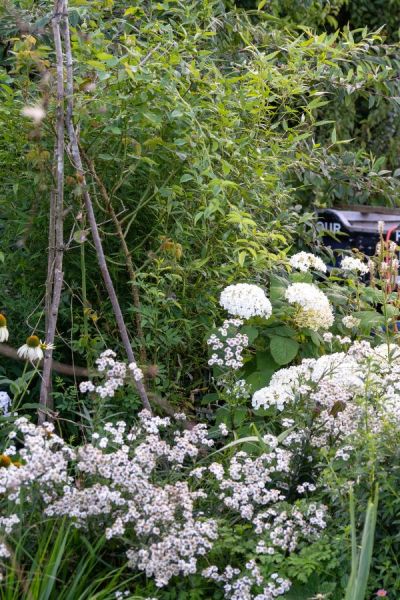
Favourite white flowers, such as white valerian, echinacea and hydrangeas in Kathy’s white borders.
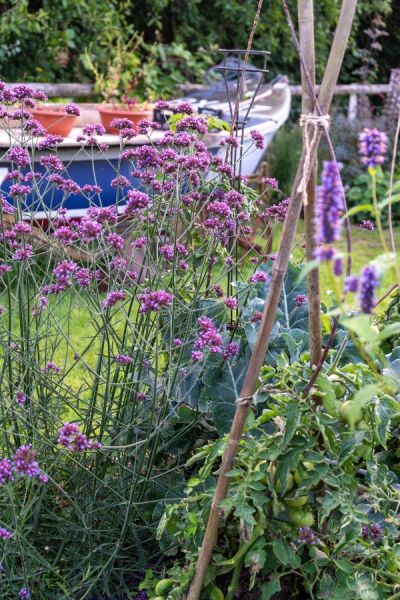
Verbena is one of Kathy’s top cottage garden plants and it’s planted here with Agastache Blackadder, kale and tomatoes. Cottage gardens mix veg and flowers in the same borders.
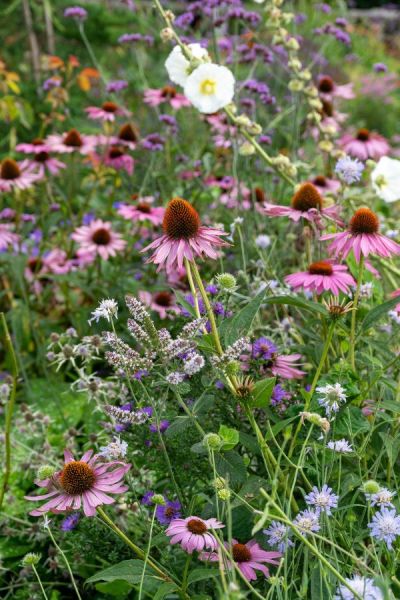
The final pair of borders is more multi-coloured with scabious, echinacea, herbs and hollyhocks – all top cottage garden plants.
Rustic cottage garden arches
There is a grass path running down the centre of the garden, with rustic arches placed at intervals. Kathy and Stuart made these themselves out of hazel poles. ‘Don’t use willow,’ says Kathy. ‘It roots too easily.’
They wedged the hazel poles fairly deeply in the earth, then bent them over and secured them with strong ties.
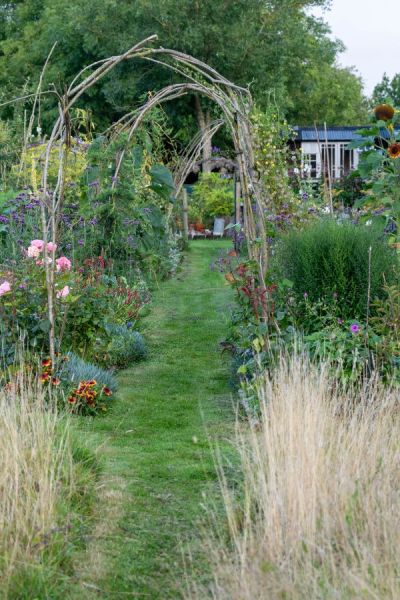
These arches are made of hazel poles, which are less likely to root and grow than willow is.
Upcycling and thrifting – the key to cottage garden style
Rustic cottage garden style isn’t about buying things. It’s about using what you’ve got or finding something that no-one else wants.
One of Kathy’s most innovative upcycling projects was turning an old sofa seat into a pretty, rusting trellis for the side of the shed. It was a sprung sofa seat, so all she needed to do was detach it from the frame, removed the padding and fabric and she had a metal frame to hang on the wall.
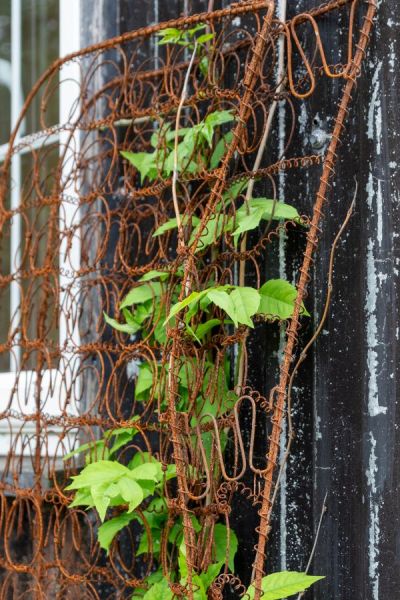
The upcycled sofa seat turned into a garden trellis.
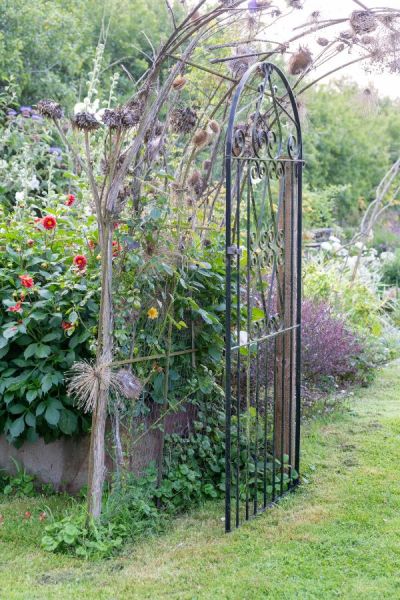
Kathy saw this arch (separately from the gate) lying apparently discarded. She checked with the owners who were happy for her to take it away. It already had chicken wire on it, and Kathy ties dried allium heads to it. They almost look like metallic ornaments.
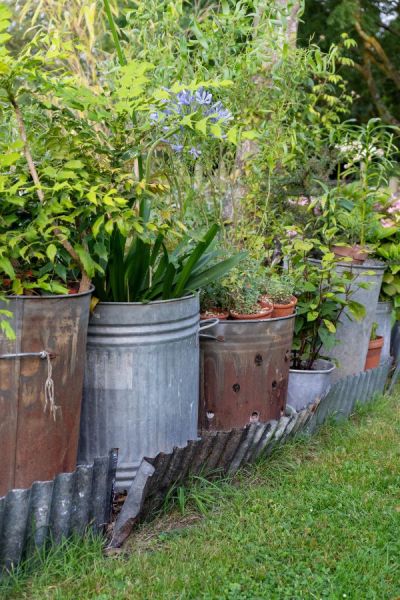
Kathy uses old bins and buckets for planters, along with pots that friends have given her. ‘If someone thinks a pot is getting too shabby for their garden, they know I’ll always use it,’ she says.
See this post for more tips on recycling, thrifting and upcycling in the garden.
See more of Kathy’s rustic cottage garden in video!
Take a stroll through Kathy’s rustic cottage garden in this video here.
Pin to remember rustic cottage garden on a budget
And do join us – see here for a free weekly email with more gardening tips, ideas and inspiration.
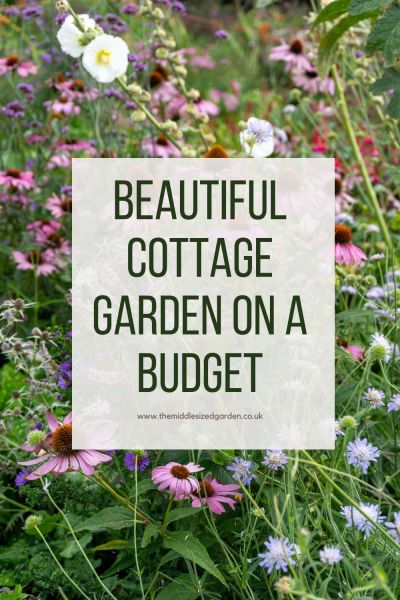

























Dear Alexandra,
For some reason unknown to me I did not receive your last email of August 19th, 2023.
That is the reason why I subscribe again.
I really like your garden ideal and suggestions.
Best regards,
Karin from Germany
Ah, thank you – I’m afraid the answer is that I didn’t send an email out. I should have notified everyone, so I apologise and thank you for noticing, with best wishes, Alexandra
PS I had delays in doing the video editing and I usually send the post and video out together on the email.